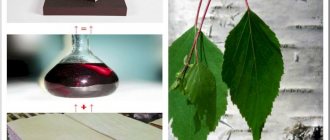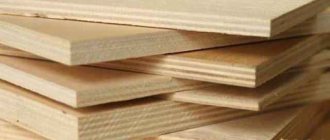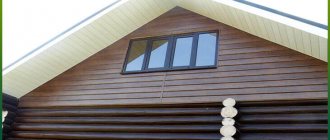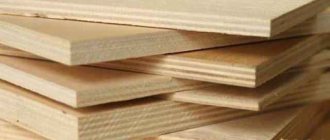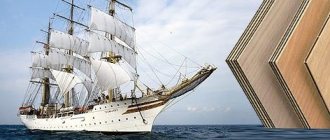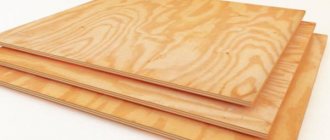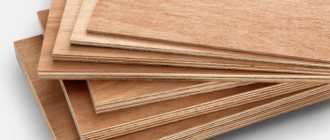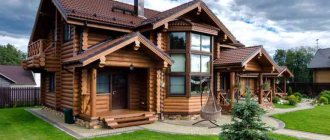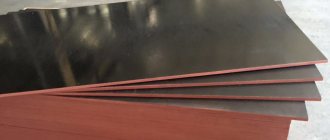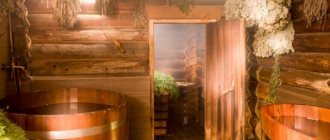Scope of plywood and its characteristics
Plywood is a sheet building material made from several thin layers of wood that are tightly glued together along their thickness (the so-called veneer). Typically, the fibers in adjacent layers of veneer are perpendicular to each other, which is why plywood is characterized by stability of shape and strength in different directions, which distinguishes it from ordinary wood. The most durable plywood is made from birch veneer. In addition, there are special types of plywood that have increased resistance to torsion and bending: they are glued together in such a way that the veneer fibers are located at an angle of 30°, 45° or 60° to adjacent layers or sheet edges. The number of layers in a plywood sheet is almost always odd: three, five, seven, nine or more, with the veneer placed symmetrically around the central layer, in which case the plywood is less susceptible to warping. But plywood is also produced from four layers: the wood fibers of the two central layers run parallel to each other, and the fibers of the outer layers are directed perpendicular to the inner ones. This perpendicular arrangement of adjacent layers achieves uniform tensile strength in all directions at once. Plywood sheets are most often assembled from layers of veneer, the material for which was one type of wood. For the production of furniture and doors, veneered joinery with decorative trim and cladding is often used.
The water resistance of plywood largely depends on the type of glue used to glue the layers of wood together.
Sheet sizes
The dimensions of the slabs are determined in accordance with the standards specified in GOST. It is possible to manufacture products in other formats, but only if the required parameters are met.
The division of plywood by size is arbitrary and depends more on the availability of appropriate equipment from the manufacturer; in addition, when ordering a large batch of material, plywood can be cut to the customer’s size
The most popular sizes are:
- FC sheets are most often produced with dimensions of 1515 x 1525 mm and thicknesses of 3, 4, 8, 10, 12, 15 and 20 mm. Such products are small-format and are excellent for indoor work.
- FSF slabs are in demand in different sizes: length – 2400 and 3000 mm, width – 1220 and 1500 mm, thickness – 9, 12, 15, 18, 21 and 24 mm. Large dimensions provide the ability to quickly finish the building outside.
Since FSF sheets are the most in demand, the size range of this material is the widest
- FBS products have dimensions of 1525 x 1525 mm and thicknesses of 10, 12, 15, 18, 20, 21, 25, 27 and 30 mm. The material is quite durable and can withstand even severe mechanical stress.
- FBV has dimensions of 1220 x 2440 mm, thickness - 7, 10, 12, 15, 18 and 21 mm.
To produce high-quality moisture-resistant plywood, only birch veneer is used. The degree of sanding can also affect the parameters of resistance to moisture: complete processing eliminates the presence of fine pile, which absorbs excess liquid most quickly.
Attention! Bakelized plywood has the largest dimensions; the length of the panels can reach 5.7 and 7.7 m. This format is excellent for finishing without numerous seams.
Moisture-resistant sheets with bakelite impregnation are expensive, so when purchasing it is useful to know the general transportation parameters of the material
Plywood grades depending on water resistance
FK grade plywood - gluing is done with urea resin. Designed for indoor use.
Plywood brand FSF (increased moisture resistance) - layers are glued together with phenolic resin. Can be used both indoors and outdoors.
FB grade plywood (bakelized plywood) - glued together after impregnation with bakelite varnish. Can be used in tropical climates, sea water and other types of aggressive environments.
FOF plywood (laminated plywood) is birch plywood lined on one or both sides with a film coating (paper impregnated with synthetic resin).
Types of plywood by raw material composition
Birch. Used under increased loads when greater material strength is required. Waterproof FC is made from birch. Birch plywood owes its strength to the good physical characteristics of the wood itself and the multi-layer structure of the plywood. Due to its strength, it is widely used, for example, in the carriage industry, automotive industry and construction, that is, where the strength of the material is important, as well as for the production of packaging and containers. Another advantage of birch plywood is its external beauty (aesthetically pleasing wood structure and warm colors), which, combined with high-quality exterior finishing, has made such plywood a favorite material for exterior, interior and furniture making.
Coniferous. It is made of coniferous wood and is relatively light in weight. Such plywood is most often made from pine, the wood of which provides the plywood sheets with an attractive appearance and sufficient strength with low weight. Due to its advantages, it is often used in the construction of houses: in the construction of buildings for cladding walls, covering roofs, laying foundations for floors and constructing partitions. This plywood resists fungus and rot well, all thanks to impregnation with resins and gluing using phenol-formaldehyde glue. The attractive color and texture of wood have led to the spread of coniferous plywood in furniture production, where it is one of the most important materials, as well as in exterior and interior design. This plywood is used for roofing work; its service life is no less than that of a soft roof. During use, the dimensions of the coniferous plywood sheets change slightly: thickness changes by 0.03%, width and length by 0.02%.
Combined. This is the name of a plywood board, the veneer layers of which are made from different types of trees, which are located symmetrically with respect to the layer in the center. An example is Combi Twin plywood, in which the outer layers and inner layer are made of birch, while the inner layers are an alternation of birch and pine needles. “Combi” is when there is birch outside, birch and pine needles inside; “Twin” - birch makes up the outer layers of veneer, with only pine needles inside. Combined plywood looks beautiful and costs less than solid birch (the price is reduced by the use of layers of coniferous plywood, which is cheaper than birch), so it is widely used for making furniture and in interior decoration. Combined plywood combines the low cost of coniferous plywood and the strength of birch plywood, being only slightly inferior in strength to birch plywood.
Laminated. Laminated plywood is the most resistant to environmental conditions, both natural and chemical. Therefore, such plywood is very popular in the manufacture of wear-resistant surfaces, such as advertising billboards, ship decks, car and van linings, and concrete formwork forms. What adds to the popularity of laminated plywood is the ability to choose the type of surface (embossed or smooth) and the base for the laminate (birch or combined plywood). During production, laminated plywood is coated on both sides with a paper-resin film based on phenol-formaldehyde resin. This type of plywood is characterized by high density, resistance to wear and moisture. There is also large-format laminated plywood, the dimensions of which allow it to be used for the construction of large objects.
Description of advantages and other nuances
So, moisture-resistant plywood is widely used in the construction of houses and cottages. It is also used in frame construction or when carrying out facade work. It is even used in mechanical engineering and beyond. What makes plywood moisture resistant? Due to the fact that special adhesives and resins are used in its manufacture.
As already presented above, there are many types of moisture-resistant plywood, but the most resistant material is FC. The only more reliable type is plywood marked FSF. As for the most durable option, this is, of course, bakelite plywood sheets. They are the ones most often used to create ships.
To create moisture-resistant plywood, birch veneer, coniferous trees and their combinations are used. Birch plywood, as practice shows, is more durable and withstands any climatic influence well. In addition, the material has a beautiful appearance. Due to this, birch plywood is more popular, although it costs an order of magnitude more.
What do the parameters of moisture-resistant plywood depend on? On the concentration level of individual substances in the adhesive composition. Based on this, moisture-resistant plywood is divided into three classes:
- FC is an average level of moisture resistance. In this case, the adhesive composition of the material contains urea resins.
- FSF – high level. The adhesive composition is made using phenolic resins. Laminated varieties of material have an even higher level of moisture resistance.
- FB is the highest level of moisture resistance. Material with this marking resists moisture especially strongly, as well as any aggressive influence. This is because the plywood is treated with impregnation and sizing with bakelite varnish.
Moisture-resistant plywood with FC marking has the lowest cost. It is made from birch and pine veneer, which is glued together with formaldehyde resins or urea analogues. FC plywood, if used in too humid conditions, begins to warp and swell. At the same time, the material attracts buyers not only with its attractive price, but also with its non-toxicity.
FSF obtains higher moisture resistance qualities due to the fact that the veneer is treated with phenol-formaldehyde resins, which are practically insoluble in water. All this is good, but finished plywood is highly toxic, so it cannot be used for interior work.
If we take a closer look at laminated plywood, then in addition to its excellent moisture-resistant qualities, it also looks very beautiful. It should be remembered that this type of plywood is more expensive. In addition, laminated material can be used for both internal and external work - in this case it all depends on the brand of plywood.
Plywood varieties
Grade I - practically no defects. Acceptable: unfused, partially fused and falling out knots and holes from them, wormholes no more than 6 mm in diameter and no more than 3 pieces per m2, no more than 5 large fused knots up to 15 mm in diameter per m2, medium-sized brown veins. It is not covered with anything or varnished. Laminated plywood is produced from this grade.
Grade II - acceptable: unfused, partially fused and falling out knots and holes from them, wormholes no more than 6 mm in diameter and no more than 6 pieces per m2, no more than 10 large fused knots up to 25 mm in diameter per m2, repair of the external one is possible parts of the leaf. Open defects must be sealed with veneer inserts. Covered with paints and finishing materials.
Grade III - acceptable: unfused, partially fused and falling out knots and holes from them, wormholes no more than 6 mm in diameter and no more than 10 pieces per m2, there is no limit on the number of large fused knots. It is used in the manufacture of structures that are not open to external view, as well as packaging materials and containers.
Grade IV - any manufacturing defects are acceptable: all types of knots, holes from under them, wormholes no more than 40 mm in diameter, good gluing is guaranteed. Designed for the production of durable packaging and containers.
